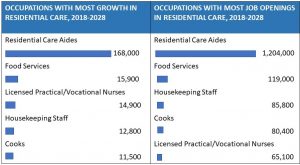To Achieve Person-Centered Residential Care, We Must Improve Direct Care Jobs – Robert Espinoza, PHI
Robert Espinoza, Vice President of Policy, PHI
www.PHInational.org
 Recent data show that about 811,000 people in this country live in residential care settings, which serve as an alternative to nursing homes and home care for individuals who want or need a certain level of housing with support. As the U.S. population continues to age rapidly, the residential care landscape will also continue to surge.
Recent data show that about 811,000 people in this country live in residential care settings, which serve as an alternative to nursing homes and home care for individuals who want or need a certain level of housing with support. As the U.S. population continues to age rapidly, the residential care landscape will also continue to surge.
Because workers interface with residents on a daily basis and are central to their overall well-being, a person-centered work culture is a key part of creating person-centered residential care settings. This article describes the residential care aide workforce (who represent most workers in these settings), including its key characteristics and primary challenges. It also outlines how both employers and policymakers can strengthen this workforce to enhance care for individuals living in these settings.
THE RESIDENTIAL CARE AIDE WORKFORCE
Residential care aides (i.e., direct care workers employed in residential care settings such as assisted living) are central to the delivery of high-quality services and supports to residents in those settings. They assist residents with activities of daily living, such as bathing, dressing, eating, toilet care, and mobility, and they provide critical social and emotional support to these residents. Residential care aides currently account for 16 percent of the total direct care workforce, which also includes home care workers, nursing assistants in nursing homes, and direct care workers in other settings.
These aides spend more time with residents than any other health or long-term care staff, which means that they are well-positioned to identify and report changes in a resident’s condition, while responding to their needs and aspirations. Though emotionally rewarding, this work is physically and emotionally taxing, requiring residential care aides to develop a range of complex skills, including communication, problem-solving, and conflict resolution skills, among others.
Along with the residential care sector overall, the residential care aide workforce has grown over the past decade, reflecting many people’s preferences for receiving long-term care in community-based care settings. Between 2009 and 2019, this workforce grew from 571,000 workers to nearly 735,000 workers. And it will continue to grow; job growth among residential care aides far outnumbers job growth for other occupations in residential care, including food servers, licensed practical/vocational nurses, housekeeping staff, and cooks. (See figures below.) Yet the hardships described below drive many workers out of these roles and will make it nearly impossible, without interventions, for residential care employers to fill these jobs in the year ahead. From 2018 to 2028, long-term care employers will need to fill 1.2 million direct care job openings in residential care, including about 168,000 new jobs and more than a million job openings created by workers leaving this sector or the labor force altogether. In many parts of the country, employers in long-term care compete unsuccessfully with retail and fast food for the same candidates.

KEY CHALLENGES
Despite their enormous value, residential care aides struggle with many profound challenges. According to PHI’s latest annual research, residential care aides earn a median wage of $12.69 and median annual earnings of $21,100; as a result, 41 percent of these workers live in or near poverty. Training and advancement opportunities for these workers are also inadequate, and the general lack of recognition and respect afforded to their jobs harms both workers and consumers—while also preventing meaningful reforms in policy and practice. Additionally, because these workers are largely women, mostly people of color, and increasingly immigrants, they must navigate these poor-quality jobs in the context of widespread systemic inequalities.
Without significant policy and practice reforms, this workforce will continue to struggle financially, and employers will not be able to recruit and retain enough workers to provide their residents with high-quality, person-centered services and supports. Residential care settings need robust, innovative models in practice and policy that transform this workforce and help realize person-centered care.
A NEW STANDARD FOR RESIDENTS AND STAFF
The Mayer-Rothschild Foundation Designation of Excellence in Person-Centered Long-Term Care project aims to create a new standard for residential care in this country. Toward this goal, a variety of worker-centered practices and policy solutions can ensure that both residents and workers thrive in these settings.
PHI’s framework, The 5 Pillars of Direct Care Job Quality, outlines 29 strategies to improve the quality of direct care jobs across five pillars: quality training, fair compensation, quality supervision and support, respect and recognition, and real opportunity. Residential care employers should aim to adopt these strategies to improve job satisfaction, retention, and recruitment (among other benefits), rooting them in person-centered and worker-centered principles. As a result, residents will be more likely to receive high-quality care.
Workforce interventions can also help residential care environments improve both care and employment-related outcomes. A few years ago, PHI worked with the Villas at Killearn Lakes, an assisted living and memory care home in Tallahassee, Florida, to improve how residential care aides (referred to as “care partners” at the Villas) engaged residents in delivering person-centered care. This intervention also enhanced how this employer supported staff to meet their needs. Residential care settings can draw from these and many other interventions to promote quality care through quality jobs.
Strengthening the residential care aide workforce to enhance person-centered care is also a matter of public policy. PHI recently released a federal priorities report that offers nearly 50 recommendations for improving direct care jobs that can be taken on by the White House, Congress, and various federal departments and agencies. The rules, regulations, and funding streams that originate with the federal government directly impact how residential care settings support both workers and residents. To the best extent possible, providers should advocate for a new federal landscape for this sector.
LOOKING AHEAD
Venecia Bradley, a Care Partner at Villas of Killearn Lakes, recently said of her role as a residential care aide, “Caregiving, in general, is a lovely thing. Caring for somebody feels amazing, and helping people really is the best way of giving back.”
Residential care aides know the value of their work and should be adequately compensated, trained, and supported. Creating a person-centered workplace will help equip them in delivering high-quality, person-centered services and supports to the hundreds of thousands of residents living in residential care environments—and the many who will follow them.


